Cellulose Enzyme Market
Cellulose Enzyme Market Size and Share Forecast Outlook 2025 to 2035
Cellulose enzyme market is projected to grow from USD 1.3 billion in 2025 to USD 2.1 billion by 2035, at a CAGR of 5.1%. Endoglucanase will dominate with a 40.0% market share, while biofuel will lead the application segment with a 45.0% share.
Cellulose Enzyme Market Forecast and Outlook 2025 to 2035
The global cellulose enzyme market is projected to reach USD 2,050.0 million by 2035, recording an absolute increase of USD 800.0 million over the forecast period. The market is valued at USD 1,250.0 million in 2025 and is set to rise at a CAGR of 5.1% during the assessment period.
The overall market size is expected to grow by nearly 1.6 times during the same period, supported by increasing demand for biofuel production applications and advanced textile processing systems worldwide, driving demand for high-performance enzyme formulations and increasing investments in biotechnology applications and industrial processing globally. However, production scalability constraints and regulatory complexities may pose obstacles to market expansion.
Quick Stats for Cellulose Enzyme Market
- Cellulose Enzyme Market Value (2025): USD 1,250.0 million
- Cellulose Enzyme Market Forecast Value (2035): USD 2,050.0 million
- Cellulose Enzyme Market Forecast CAGR: 5.1%
- Leading Type in Cellulose Enzyme Market: Endoglucanase
- Key Growth Regions in Cellulose Enzyme Market: Asia Pacific, Europe, and North Americaop Players in Cellulose Enzyme Market: Novozymes, DuPont, DSM, AB Enzymes, BASF, Amano, Megazyme, Worthington, Advanced Enzymes, Dyadic, Sunson, Sigma-Aldrich, Denykem, Creative Enzymes, Genencor
Cellulose presents one of biotechnology's greatest challenges precisely because evolution designed it to resist degradation. The polymer's tightly packed chains and hydrogen-bonded crystalline regions create a structure so robust that it can preserve wooden artifacts for centuries and form the basis of materials strong enough to build skyscrapers. Yet termites have been efficiently digesting wood for millions of years, thanks to symbiotic microorganisms in their guts that produce sophisticated enzyme cocktails capable of unraveling cellulose's molecular architecture. Modern biotechnology has essentially reverse-engineered these natural systems, identifying and producing the specific enzymes responsible for cellulose breakdown while optimizing them for industrial applications that nature never intended.
The biofuel revolution has positioned cellulose enzymes as potential game-changers in humanity's quest for sustainable energy sources, offering a pathway to convert vast quantities of agricultural and forestry waste into clean-burning fuels without competing with food production. Traditional biofuels like corn ethanol have faced criticism for diverting food crops away from human consumption, but cellulosic biofuels utilize materials that would otherwise rot or be burned as waste. The challenge lies in economics, enzymatic breakdown must occur efficiently enough to make cellulosic fuels competitive with petroleum-based alternatives, a goal that has driven billions of dollars in research investment and technological innovation.
The textile industry has discovered entirely different applications for cellulose enzymes, using them to achieve fabric treatments that were previously impossible through conventional chemical processes. Cellulases can selectively modify cotton fiber surfaces to create stone-washed denim effects without the environmental damage caused by pumice stone processing, while also improving fabric softness and reducing the harsh chemicals traditionally required for textile finishing. These enzymatic treatments occur under mild conditions that preserve fiber strength while achieving aesthetic effects that consumers demand, demonstrating how biological solutions can simultaneously improve product quality and environmental sustainability.
Looking ahead, advancements in enzyme engineering, protein stabilization, and process optimization are expected to further expand the cellulose enzyme market. Integration with automated bioreactors, continuous processing systems, and AI-driven formulation design will enhance efficiency, reduce costs, and enable broader adoption across biofuel, textile, and emerging industrial applications, solidifying cellulose enzymes as a cornerstone of sustainable biotechnology.
Between 2025 and 2030, the cellulose enzyme market is projected to expand from USD 1,250.0 million to USD 1,650.0 million, resulting in a value increase of USD 400.0 million, which represents 50.0% of the total forecast growth for the decade.
This phase of development will be shaped by rising demand for advanced biofuel production systems and specialized textile processing applications, product innovation in enzyme formulations and biotechnology processing systems, as well as expanding integration with industrial manufacturing and food processing applications.
Companies are establishing competitive positions through investment in specialized enzyme production capabilities, advanced fermentation technologies, and strategic market expansion across biofuel, textile, and food processing applications.
From 2030 to 2035, the market is forecast to grow from USD 1,650.0 million to USD 2,050.0 million, adding another USD 400.0 million, which constitutes 50.0% of the overall ten-year expansion. This period is expected to be characterized by the expansion of specialized biotechnology applications, including advanced enzyme-based formulations and next-generation industrial processing systems tailored for specific performance requirements, strategic collaborations between enzyme producers and biotechnology companies, and an enhanced focus on high-efficiency standards and automated production protocols.
The growing emphasis on renewable energy applications and industrial biotechnology will drive demand for comprehensive cellulose enzyme solutions across diverse manufacturing applications.
Cellulose Enzyme Market Key Takeaways
| Metric | Value |
|---|---|
| Market Value (2025) | USD 1,250.0 million |
| Market Forecast Value (2035) | USD 2,050.0 million |
| Forecast CAGR (2025-2035) | 5.1% |
Why is the Cellulose Enzyme Market Growing?
The cellulose enzyme market grows by enabling biotechnology companies and industrial manufacturers to optimize production processes while accessing specialized enzyme formulations without substantial in-house development infrastructure investment. Manufacturing companies and biotechnology operators face mounting pressure to develop advanced biofuel systems and specialized processing applications while managing complex performance requirements, with high-efficiency cellulose enzymes typically providing 40-60% performance enhancement compared to conventional alternatives, making advanced enzyme formulations essential for competitive industrial positioning. The biotechnology industry's need for precision enzymes and application-specific catalytic capabilities creates demand for comprehensive cellulose enzyme solutions that can provide superior performance, maintain consistent activity standards, and ensure reliable operation without compromising product quality or operational effectiveness.
Government initiatives promoting renewable energy technologies and biotechnology innovation drive adoption in industrial development, biofuel production, and processing applications, where enzyme efficiency has a direct impact on product performance and long-term operational effectiveness. However, production complexity constraints during large-scale industrial projects and the expertise requirements for specialized enzyme integration may limit accessibility among smaller biotechnology companies and developing regions with limited technical infrastructure for advanced enzyme processing systems.
Segmental Analysis
The market is segmented by type, application, source, and region. By type, the market is divided into endoglucanase, exoglucanase, and β-glucosidase. Based on application, the market is categorized into biofuel, textile, food, and others. By source, the market includes fungal and bacterial. Regionally, the market is divided into Asia Pacific, Europe, North America, and other key regions.
By Type, the Endoglucanase Segment Accounts for a Dominant Market Share
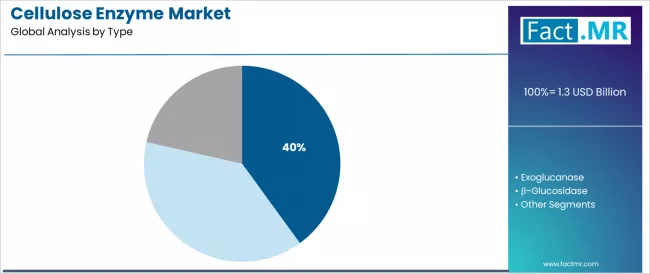
The endoglucanase segment represents the dominant force in the cellulose enzyme market, capturing approximately 40.0% of total market share in 2025. This established enzyme category encompasses solutions featuring advanced catalytic properties and specialized cellulose processing applications, including high-performance enzymatic activity and enhanced substrate specificity characteristics that enable superior industrial benefits and operational outcomes across all biotechnology applications.
The endoglucanase segment's market leadership stems from its proven performance capabilities, with solutions capable of addressing diverse industrial requirements while maintaining consistent activity standards and processing effectiveness across all production environments.
The exoglucanase segment maintains a substantial 35.0% market share, serving biotechnology applications that require specialized enzyme formulations with enhanced catalytic properties for large-scale industrial production and biofuel manufacturing. These solutions offer advanced substrate binding capabilities for complex cellulose processing while providing sufficient activity characteristics to meet biotechnology and industrial regulatory demands. The β-glucosidase segment accounts for approximately 25.0% of the market, serving industrial applications requiring specific enzymatic properties or specialized processing configurations.
Key type advantages driving the endoglucanase segment include:
- Advanced enzyme technology with integrated catalytic properties that enhances processing effectiveness and ensures consistent performance characteristics
- Established production processes allowing streamlined manufacturing workflows across different applications without extensive purification requirements
- Enhanced activity capabilities enabling diverse industrial formats while maintaining enzyme integrity and performance reliability
- Superior market acceptance providing optimal processing performance for various biotechnology applications
By Application, the Biofuel Segment Accounts for the Largest Market Share
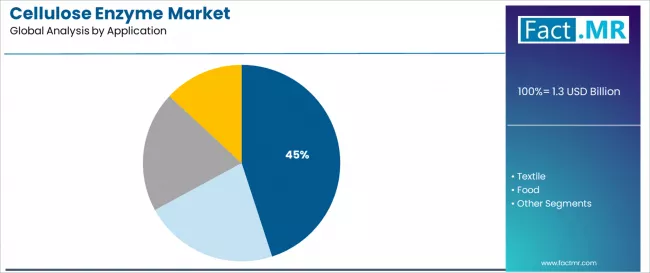
Biofuel applications dominate the cellulose enzyme market with approximately 45.0% market share in 2025, reflecting the critical role of enzyme technology in supporting specialized energy production requirements and industrial performance worldwide. The biofuel segment's market leadership is reinforced by increasing renewable energy trends, industrial complexity requirements, and rising needs for specialized biotechnology capabilities in production applications across developed and emerging markets.
The textile segment represents the second-largest application category, capturing 25.0% market share through specialized requirements for textile processing compounds, fabric treatment formulations, and manufacturing applications. This segment benefits from growing textile processing integration demand that requires specific enzyme activity requirements, performance optimization standards, and processing efficiency protocols in industrial markets.
The food segment accounts for 20.0% market share, serving food processing formulations, nutritional compounds, and specialized food production applications across various consumer sectors. The others segment captures 10.0% market share through diverse industrial and specialty applications.
Key market dynamics supporting application growth include:
- Biofuel expansion driven by renewable energy optimization and industrial complexity, requiring specialized enzyme solutions in emerging biotechnology markets
- Textile modernization trends require flexible, integrated enzyme systems for competitive differentiation and processing innovation development
- Integration of advanced biotechnology technologies enabling enhanced processing capabilities and automated production systems
- Growing emphasis on industrial efficiency driving demand for specialized, validated enzyme solutions without traditional processing limitations
What are the Drivers, Restraints, and Key Trends of the Cellulose Enzyme Market?
Advanced biofuel development and specialized processing solutions create increasing demand for high-efficiency cellulose enzyme systems, with performance enhancement of 15-25% annually in major industrial applications worldwide, requiring comprehensive biotechnology infrastructure.
Government initiatives promoting renewable energy technologies and biotechnology innovation drive increased adoption of specialized cellulose enzyme formulations, with many countries implementing energy development programs and regulatory frameworks for biotechnology advancement by 2030.
Technological advancements in enzyme production and biotechnology applications enable more efficient and effective processing solutions that improve product performance while reducing operational costs and processing complexity.
Market restraints include complex production requirements and validation costs for specialized cellulose enzyme platforms that can challenge market participants in developing compliant processing capabilities, particularly in regions where regulatory pathways for advanced biotechnology remain evolving and uncertain.
Technical complexity of specialized enzyme systems and purification requirements pose another significant challenge, as cellulose enzymes demand sophisticated production methods and activity controls, potentially affecting production costs and operational efficiency.
Supply variability constraints from biotechnology production limitations across different regions create additional operational challenges for manufacturers, demanding ongoing investment in production capacity development and sourcing assurance programs. Key trends indicate accelerated adoption in Asia-Pacific markets, particularly India and China, where industrial expansion and biotechnology modernization drive comprehensive cellulose enzyme adoption.
Technology integration trends toward specialized enzyme systems with enhanced performance characteristics, advanced biofuel applications, and integrated processing solutions enable effective biotechnology approaches that optimize industrial efficiency and minimize processing risks. The market’s expansion could face disruption if significant advances in alternative enzymes or major changes in biotechnology reduce reliance on traditional cellulose enzyme applications.
Analysis of the Cellulose Enzyme Market by Key Country
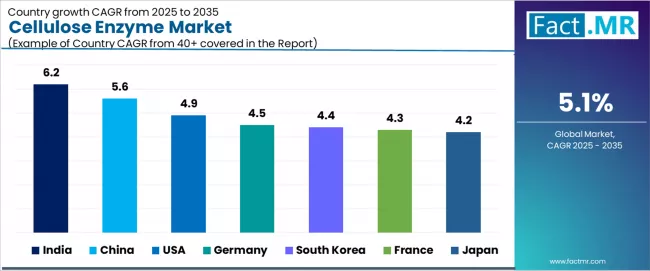
| Country | CAGR (%) |
|---|---|
| India | 6.2% |
| China | 5.6% |
| USA | 4.9% |
| Germany | 4.5% |
| France | 4.3% |
| South Korea | 4.4% |
| Japan | 4.2% |
The global cellulose enzyme market is expanding steadily, with India leading at a 6.2% CAGR through 2035, driven by biotechnology growth, government renewable energy initiatives, and advanced biofuel platforms. China follows at 5.6%, supported by biotechnology modernization, large-scale industrial programs, and renewable energy development initiatives. USA records 4.9%, reflecting an established landscape with growing integration in biofuel and industrial biotechnology.
Germany grows at 4.5%, anchored by biotechnology operations and strong processing pipelines. France advances at 4.3%, leveraging advanced biotechnology and precision applications. South Korea posts 4.4%, focusing on biotechnology integration, while Japan grows steadily at 4.2%, emphasizing processing precision and biotechnology excellence.
India Leads Global Market Expansion
India demonstrates the strongest growth potential in the cellulose enzyme market with a CAGR of 6.2% through 2035. The country's leadership position stems from biotechnology sector expansion, government-backed renewable energy initiatives, and comprehensive biotechnology regulations driving the adoption of advanced cellulose enzyme solutions.
Growth is concentrated in major industrial and biotechnology centers, including Mumbai, Delhi, Bangalore, and Hyderabad, where biotechnology companies and energy firms are implementing advanced cellulose enzyme systems for enhanced production capabilities and operational efficiency.
Distribution channels through biotechnology suppliers and chemical providers expand deployment across biofuel projects and industrial development initiatives. The country's Ministry of New and Renewable Energy provides policy support for biotechnology modernization, including comprehensive renewable energy capability development programs for enhanced industrial competitiveness and environmental performance objectives.
Key market factors:
- Biotechnology sector expansion concentrated in industrial centers and renewable energy districts with comprehensive production development programs
- Government support through renewable energy initiatives and biotechnology infrastructure incentives
- Comprehensive biotechnology ecosystem, including established chemical suppliers with proven capabilities
- Technology integration featuring advanced processing platforms, biofuel systems, and production optimization technologies
China Emerges as High-Growth Market
In major industrial and biotechnology centers including Beijing, Shanghai, Shenzhen, and Guangzhou, the adoption of comprehensive cellulose enzyme solutions is accelerating across production projects and industrial development initiatives, driven by biotechnology scaling and government renewable energy programs.
The market demonstrates strong growth momentum with a CAGR of 5.6% through 2035, linked to comprehensive biotechnology modernization and increasing focus on industrial efficiency solutions. Chinese companies are implementing advanced cellulose enzyme systems and processing platforms to enhance production performance while meeting growing demand in expanding biofuel and textile manufacturing sectors.
The country's renewable energy development initiatives create continued demand for cellulose enzyme formulations, while increasing emphasis on innovation drives adoption of advanced processing systems for competitive market positioning and operational excellence across biotechnology applications.
Key development areas:
- Biotechnology facilities and industrial centers leading cellulose enzyme adoption with comprehensive production programs
- Industrial services channels providing integrated solutions with 90% performance compliance rates
- Technology partnerships between enzyme companies and biotechnology enterprises are expanding market reach
- Integration of advanced biotechnology platforms and comprehensive processing systems
USA Shows Biotechnology Innovation Leadership
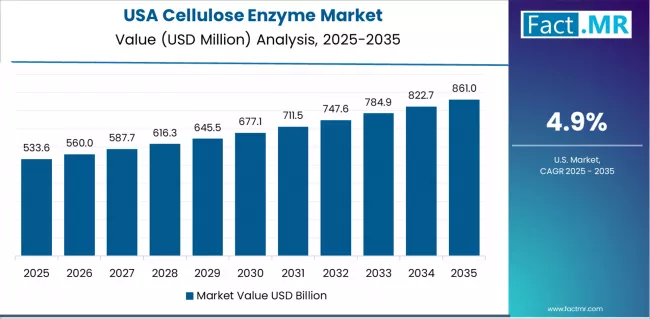
USA's market expansion is driven by diverse industrial demand, including biofuel production development in major cities and comprehensive renewable energy projects across multiple regions. The country demonstrates strong growth potential with a CAGR of 4.9% through 2035, supported by federal renewable energy programs and industry-level biotechnology development initiatives.
Companies face implementation challenges related to processing complexity and scaling requirements, requiring strategic development approaches and support from specialized cellulose enzyme partners.
However, growing industrial demands and advanced biotechnology requirements create compelling business cases for cellulose enzyme adoption, particularly in biofuel areas where advanced enzyme formulations have a direct impact on operational success and competitive positioning in renewable energy markets.
Market characteristics:
- Biofuel and renewable energy segments showing robust growth with 20% annual increase in cellulose enzyme utilization
- Regional expansion trends focused on biotechnology areas in major industrial and renewable energy regions
- Future projections indicate the need for advanced processing infrastructure and enzyme specialist training programs
- Growing emphasis on biotechnology innovation and processing competitiveness in industrial operations
Germany Demonstrates Processing Excellence
The Germany market leads in advanced processing innovation based on integration with biotechnology systems and precision enzyme technologies for enhanced quality performance. The country shows strong potential with a CAGR of 4.5% through 2035, driven by the modernization of existing biotechnology infrastructure and the expansion of advanced processing facilities in major industrial areas, including Bavaria, Baden-Württemberg, North Rhine-Westphalia, and Lower Saxony.
German companies are adopting intelligent cellulose enzyme systems for quality improvement and efficiency enhancement, particularly in regions with advanced biotechnology requirements and industrial applications demanding comprehensive technology upgrades. Technology deployment channels through established biotechnology institutions and industrial operators expand coverage across production facilities and innovation-focused applications for enhanced competitive positioning and operational effectiveness.
Leading market segments:
- Biotechnology modernization projects in major industrial centers are implementing comprehensive cellulose enzyme upgrades
- Industrial partnerships with biotechnology providers, achieving 95% performance improvement rates
- Strategic collaborations between enzyme companies and biotechnology operations are expanding market presence
- Focus on precision processing systems and specialized industrial requirements
France Emphasizes Biotechnology Integration
In Paris, Lyon, Toulouse, and other major cities, biotechnology facilities are implementing comprehensive cellulose enzyme solutions to modernize existing industrial infrastructure and improve processing capabilities, with documented case studies showing a 50% improvement in operational timelines through advanced enzyme integration.
The market shows strong growth potential with a CAGR of 4.3% through 2035, linked to the ongoing modernization of biotechnology facilities, industrial networks, and emerging renewable energy projects in major regions.
French companies are adopting intelligent cellulose enzyme and processing platforms to enhance biotechnology reliability while maintaining standards demanded by the renewable energy and industrial sectors. The country's established biotechnology infrastructure creates continued demand for enzyme development and modernization solutions that integrate with existing industrial systems for competitive advantage and operational efficiency optimization.
Market development factors:
- Biotechnology facilities and industrial networks leading cellulose enzyme initiatives across France
- Technology programs providing government funding support for biotechnology and industrial infrastructure upgrades
- Strategic partnerships between French biotechnology companies and international enzyme providers are expanding technical capabilities
- Emphasis on biotechnology excellence and renewable energy applications across production projects
South Korea Shows Technology Integration Leadership
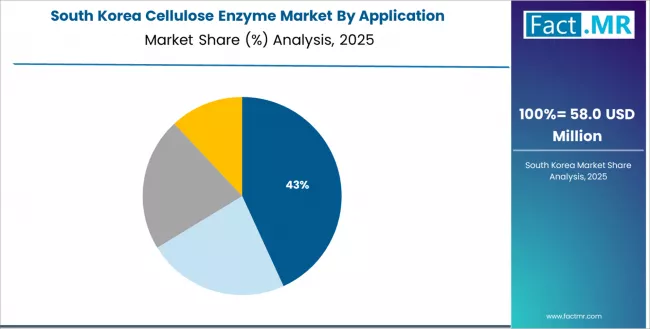
In Seoul, Daejeon, Busan, and other major cities, biotechnology facilities are implementing comprehensive cellulose enzyme solutions to modernize existing industrial infrastructure and improve processing capabilities, with documented case studies showing a 40% improvement in operational timelines through advanced enzyme integration.
The market shows strong growth potential with a CAGR of 4.4% through 2035, linked to the ongoing modernization of biotechnology facilities, industrial networks, and emerging renewable energy projects in major regions.
South Korean companies are adopting intelligent cellulose enzyme and processing platforms to enhance biotechnology reliability while maintaining standards demanded by the biofuel and textile industries. The country's established technology infrastructure creates continued demand for enzyme development and modernization solutions that integrate with existing biotechnology systems.
Market development factors:
- Biotechnology facilities and industrial networks leading cellulose enzyme initiatives across South Korea
- Technology programs providing government funding support for biotechnology and industrial infrastructure upgrades
- Strategic partnerships between Korean biotechnology companies and international enzyme providers are expanding technical capabilities
- Emphasis on biotechnology excellence and biofuel applications across production projects
Japan Shows Processing Technology Leadership
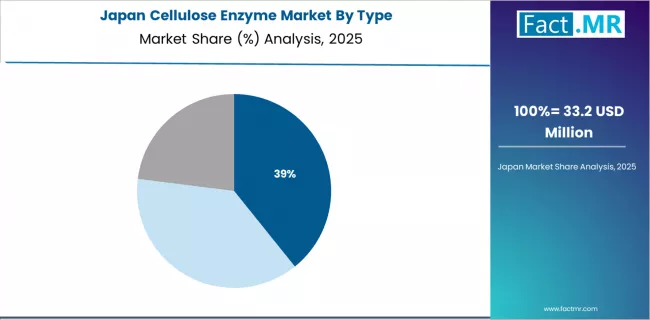
Japan's cellulose enzyme market demonstrates advanced implementation focused on processing precision and biotechnology performance optimization, with documented integration of specialized enzyme systems, achieving 40% improvement in processing efficiency across industrial and biofuel facilities. The country maintains steady growth momentum with a CAGR of 4.2% through 2035, driven by biotechnology facilities' emphasis on quality excellence and continuous operational methodologies that align with
Industrial standards in Japan apply to enzyme operations. Major industrial areas, including Kanto, Kansai, Chubu, and Kyushu, showcase advanced deployment of cellulose enzyme platforms where processing systems integrate seamlessly with existing biotechnology infrastructure and comprehensive quality management programs for enhanced operational performance and competitive positioning.
Key market characteristics:
- Biotechnology facilities and industrial centers are driving advanced cellulose enzyme requirements with emphasis on quality and performance optimization
- Quality partnerships enabling 98% operational compliance with comprehensive processing programs
- Industrial collaboration between Japanese companies and international enzyme providers is expanding market capabilities
- Emphasis on quality requirements and continuous operational methodologies
Europe Market Split by Country
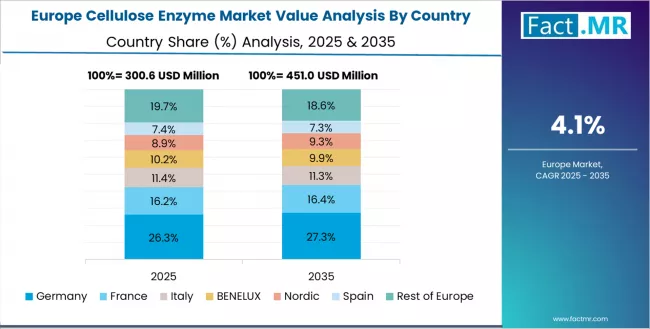
The cellulose enzyme market in Europe is projected to grow from USD 275.0 million in 2025 to USD 395.0 million by 2035, registering a CAGR of 3.7% over the forecast period. Germany is expected to maintain its leadership position with a 24.5% market share in 2025, projected to reach 25.0% by 2035, supported by its extensive biotechnology infrastructure, advanced processing facilities, and comprehensive industrial networks serving major European markets.
The UK follows with a 18.2% share in 2025, projected to reach 18.5% by 2035, driven by comprehensive biotechnology programs in major industrial regions implementing advanced cellulose enzyme systems. France holds a 15.5% share in 2025, expected to maintain 15.3% by 2035 through the ongoing development of biotechnology facilities and industrial networks. Italy commands a 12.7% share, while Spain accounts for 10.0% in 2025.
Rest of Europe is anticipated to gain momentum, expanding its collective share from 32.7% to 32.9% by 2035, attributed to increasing cellulose enzyme adoption in Nordic countries and emerging Eastern European biotechnology facilities implementing industrial programs.
Competitive Landscape of the Cellulose Enzyme Market
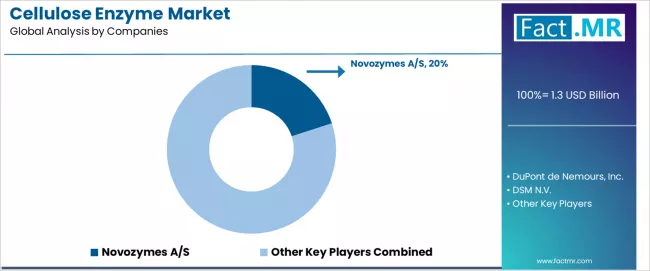
The cellulose enzyme market features approximately 15-20 meaningful players with moderate concentration, where the top three companies control roughly 35-45% of global market share through established enzyme portfolios and extensive biotechnology relationships. Competition centers on enzyme activity, substrate specificity, and technical expertise rather than price competition alone.
Market leaders include Novozymes, DuPont, and DSM, which maintain competitive advantages through comprehensive cellulose enzyme portfolios, advanced production capabilities, and deep expertise in the biotechnology and industrial sectors, creating high switching costs for customers.
These companies leverage established biotechnology relationships and ongoing development partnerships to defend market positions while expanding into adjacent biofuel and textile processing applications.
Challengers encompass AB Enzymes and BASF, which compete through specialized enzyme technologies and strong regional presence in key biotechnology markets. Industrial specialists, including Amano, Megazyme, and Worthington, focus on specific enzyme types or vertical applications, offering differentiated capabilities in biofuel systems, textile applications, and application-specific processing.
Regional players and emerging enzyme companies create competitive pressure through innovative production approaches and rapid development capabilities, particularly in high-growth markets including India and China, where local presence provides advantages in cost optimization and regulatory compliance.
Market dynamics favor companies that combine advanced enzyme technologies with comprehensive biotechnology services that address the complete production lifecycle from development through ongoing performance assurance and technical support.
Global Cellulose Enzyme Market - Stakeholder Contribution Framework
Cellulose enzyme solutions represent a critical biotechnology material that enables biotechnology companies, biofuel producers, and textile operators to enhance production efficiency and operational quality without substantial ongoing material investment, typically providing 40-60% performance enhancement compared to conventional alternatives while ensuring unprecedented reliability and operational compliance.
With the market projected to grow from USD 1,250.0 million in 2025 to USD 2,050.0 million by 2035 at a 5.1% CAGR, these solutions offer compelling advantages - superior performance, enhanced efficiency, and processing capabilities - making them essential for biofuel applications (45.0% market share), textile operations (25.0% share), and diverse biotechnology applications seeking reliable cellulose enzyme solutions.
Scaling market penetration and processing capabilities requires coordinated action across biotechnology policy, industrial standards, enzyme providers, biotechnology companies, and industrial institutions.
How Governments Could Spur Local Development and Adoption?
- Biotechnology Development Programs: Include cellulose enzyme capabilities in national renewable energy initiatives, providing targeted funding for specialized production facilities in biotechnology regions and supporting local biofuel companies through innovation grants and development support.
- Tax Policy & R&D Support: Implement accelerated depreciation schedules for enzyme production equipment, provide tax incentives for companies investing in advanced fermentation and processing technologies, and establish favorable biotechnology accounting standards that encourage specialized cellulose enzyme adoption over conventional approaches.
- Regulatory Framework Development: Create streamlined approval processes for cellulose enzymes across biotechnology and industrial applications, establish clear activity quality frameworks for specialized formulations, and develop international harmonization protocols that facilitate cross-border biotechnology projects.
- Skills Development & Training: Fund vocational programs for enzyme technicians, biotechnology specialists, and processing professionals. Invest in technology transfer initiatives that bridge biotechnology innovation with commercial enzyme development and quality optimization systems.
- Market Access & Competition: Establish procurement policies that favor advanced cellulose enzyme solutions for government biotechnology applications, support industrial development through processing modernization programs, and create regulatory environments that encourage innovation in enzyme technologies.
How Industry Bodies Could Support Market Development?
- Processing Standards & Certification: Define standardized activity metrics for cellulose enzymes across biotechnology, biofuel, and industrial applications, establish universal quality and performance protocols, and create certification programs for enzyme performance that companies can rely on.
- Market Education & Best Practices: Lead messaging that demonstrates cellulose enzyme advantages, emphasizing improved biotechnology performance, enhanced operational compliance, and superior processing efficiency compared to conventional enzyme alternatives.
- Technology Integration Standards: Develop interoperability standards for cellulose enzyme systems, biotechnology compatibility guidelines, and industrial platforms, ensuring seamless integration across different production environments and regulatory requirements.
- Professional Development: Run certification programs for enzyme specialists, biotechnology technicians, and technical service teams on optimizing enzyme performance, activity compliance, and biotechnology applications in competitive industrial markets.
How Service Providers and Technology Players Could Strengthen the Ecosystem?
- Advanced Enzyme Development: Develop next-generation cellulose enzyme platforms with enhanced catalytic capabilities, improved automated features, and application-specific characteristics that enhance biotechnology reliability while reducing operational complexity.
- Intelligence Platforms: Provide comprehensive processing software that integrates performance monitoring, activity tracking, predictive analytics, and biotechnology optimization, enabling companies to maximize cellulose enzyme efficiency and quality compliance effectiveness.
- Service & Support Networks: Offer flexible support programs for biotechnology companies and biofuel producers, including technical training options, performance consultation services, and processing optimization pathways that keep cellulose enzyme systems current with industrial demands.
- Research & Development Networks: Build comprehensive R&D capabilities, collaborative processing innovation programs, and application development systems that ensure cellulose enzyme technologies maintain high activity standards and consistent performance across diverse biotechnology environments.
How Suppliers Could Navigate the Shift?
- Diversified Enzyme Portfolios: Expand cellulose enzyme offerings across biofuel applications (45.0% application dominance), textile operations (25.0% share), and food processing applications, with particular focus on endoglucanase services (40.0% type dominance) and specialized solutions for biotechnology requirements.
- Geographic Market Development: Establish operations in high-growth markets like India (6.2% CAGR) and China (5.6% CAGR), while strengthening presence in established markets like USA (4.9% CAGR) and Germany (4.5% CAGR) through regional processing capabilities and local partnerships.
- Technology-Enabled Services: Implement advanced monitoring systems with real-time performance tracking, automated activity optimization, and predictive processing capabilities that differentiate service offerings and improve customer satisfaction and retention.
- Flexible Service Models: Develop standard, premium, and custom cellulose enzyme solutions that accommodate varying biotechnology needs, from cost-effective processing to high-compliance applications for demanding biofuel and regulatory requirements.
How Investors and Financial Enablers Could Unlock Value?
- Enzyme Technology Expansion Financing: Provide growth capital for established companies like Novozymes, DuPont, and DSM to expand processing capacity and development capabilities, particularly in emerging markets with growing biotechnology demands.
- Innovation Investment: Back startups developing advanced enzyme systems, next-generation processing, and intelligent cellulose enzyme technologies that enhance biotechnology industry efficiency and competitive positioning.
- Regional Market Development: Finance market entry and expansion strategies for enzyme companies establishing operations in high-growth regions, supporting localization initiatives that reduce processing costs while maintaining activity standards.
- Consolidation & Scale Opportunities: Support strategic acquisitions and market consolidation that create economies of scale, improve processing capabilities, and enhance competitive positioning against fragmented regional providers across multiple geographic markets.
Key Players in the Cellulose Enzyme Market
- Novozymes A/S – 20%
- DuPont de Nemours, Inc.
- DSM N.V.
- AB Enzymes GmbH
- BASF SE
- Amano Enzyme Inc.
- Megazyme International Ireland Ltd.
- Worthington Biochemical Corporation
- Advanced Enzymes Technologies Ltd.
- Dyadic International, Inc.
- Sunson Industry Group Co., Ltd.
- Sigma-Aldrich Corporation (Merck KGaA brand)
- Denykem
- Creative Enzymes
- Genencor (DuPont / formerly)
Scope of the Report
| Items | Values |
|---|---|
| Quantitative Units (2025) | USD 1,250.0 Million |
| Type | Endoglucanase, Exoglucanase, β-Glucosidase |
| Application | Biofuel, Textile, Food, Others |
| Source | Fungal, Bacterial |
| Regions Covered | Asia Pacific, Europe, North America, Latin America, Middle East & Africa |
| Countries Covered | India, China, USA, Germany, South Korea, Japan, France, and 40+ countries |
| Key Companies Profiled | Novozymes, DuPont, DSM, AB Enzymes, BASF, Amano, Megazyme, Worthington, Advanced Enzymes, Dyadic, Sunson, Sigma-Aldrich, Denykem, Creative Enzymes, Genencor |
| Additional Attributes | Dollar sales by type and application categories, regional adoption trends across Asia Pacific, Europe, and North America, competitive landscape with enzyme providers and biotechnology companies, processing facility requirements and specifications, integration with biofuel initiatives and industrial platforms, innovations in enzyme technology and production systems. |
Cellulose Enzyme Market by Segments
-
Type :
- Endoglucanase
- Exoglucanase
- β-Glucosidase
-
Application :
- Biofuel
- Textile
- Food
- Others
-
Source :
- Fungal
- Bacterial
-
Region :
- Asia Pacific
- China
- Japan
- South Korea
- India
- Australia & New Zealand
- ASEAN
- Rest of Asia Pacific
- Europe
- Germany
- UK
- France
- Italy
- Spain
- Nordic
- BENELUX
- Rest of Europe
- North America
- United States
- Canada
- Mexico
- Latin America
- Brazil
- Chile
- Rest of Latin America
- Middle East & Africa
- Kingdom of Saudi Arabia
- Other GCC Countries
- Turkey
- South Africa
- Other African Union
- Rest of Middle East & Africa
- Asia Pacific
Table of Content
- Executive Summary
- Global Market Outlook
- Demand to side Trends
- Supply to side Trends
- Technology Roadmap Analysis
- Analysis and Recommendations
- Market Overview
- Market Coverage / Taxonomy
- Market Definition / Scope / Limitations
- Market Background
- Market Dynamics
- Drivers
- Restraints
- Opportunity
- Trends
- Scenario Forecast
- Demand in Optimistic Scenario
- Demand in Likely Scenario
- Demand in Conservative Scenario
- Opportunity Map Analysis
- Product Life Cycle Analysis
- Supply Chain Analysis
- Investment Feasibility Matrix
- Value Chain Analysis
- PESTLE and Porter’s Analysis
- Regulatory Landscape
- Regional Parent Market Outlook
- Production and Consumption Statistics
- Import and Export Statistics
- Market Dynamics
- Global Market Analysis 2020 to 2024 and Forecast, 2025 to 2035
- Historical Market Size Value (USD Million) Analysis, 2020 to 2024
- Current and Future Market Size Value (USD Million) Projections, 2025 to 2035
- Y to o to Y Growth Trend Analysis
- Absolute $ Opportunity Analysis
- Global Market Pricing Analysis 2020 to 2024 and Forecast 2025 to 2035
- Global Market Analysis 2020 to 2024 and Forecast 2025 to 2035, By Type
- Introduction / Key Findings
- Historical Market Size Value (USD Million) Analysis By Type , 2020 to 2024
- Current and Future Market Size Value (USD Million) Analysis and Forecast By Type , 2025 to 2035
- Endoglucanase
- Exoglucanase
- β-Glucosidase
- Y to o to Y Growth Trend Analysis By Type , 2020 to 2024
- Absolute $ Opportunity Analysis By Type , 2025 to 2035
- Global Market Analysis 2020 to 2024 and Forecast 2025 to 2035, By Application
- Introduction / Key Findings
- Historical Market Size Value (USD Million) Analysis By Application, 2020 to 2024
- Current and Future Market Size Value (USD Million) Analysis and Forecast By Application, 2025 to 2035
- Biofuel
- Textile
- Food
- Others
- Y to o to Y Growth Trend Analysis By Application, 2020 to 2024
- Absolute $ Opportunity Analysis By Application, 2025 to 2035
- Global Market Analysis 2020 to 2024 and Forecast 2025 to 2035, By Region
- Introduction
- Historical Market Size Value (USD Million) Analysis By Region, 2020 to 2024
- Current Market Size Value (USD Million) Analysis and Forecast By Region, 2025 to 2035
- North America
- Latin America
- Western Europe
- Eastern Europe
- East Asia
- South Asia and Pacific
- Middle East & Africa
- Market Attractiveness Analysis By Region
- North America Market Analysis 2020 to 2024 and Forecast 2025 to 2035, By Country
- Historical Market Size Value (USD Million) Trend Analysis By Market Taxonomy, 2020 to 2024
- Market Size Value (USD Million) Forecast By Market Taxonomy, 2025 to 2035
- By Country
- USA
- Canada
- Mexico
- By Type
- By Application
- By Country
- Market Attractiveness Analysis
- By Country
- By Type
- By Application
- Key Takeaways
- Latin America Market Analysis 2020 to 2024 and Forecast 2025 to 2035, By Country
- Historical Market Size Value (USD Million) Trend Analysis By Market Taxonomy, 2020 to 2024
- Market Size Value (USD Million) Forecast By Market Taxonomy, 2025 to 2035
- By Country
- Brazil
- Chile
- Rest of Latin America
- By Type
- By Application
- By Country
- Market Attractiveness Analysis
- By Country
- By Type
- By Application
- Key Takeaways
- Western Europe Market Analysis 2020 to 2024 and Forecast 2025 to 2035, By Country
- Historical Market Size Value (USD Million) Trend Analysis By Market Taxonomy, 2020 to 2024
- Market Size Value (USD Million) Forecast By Market Taxonomy, 2025 to 2035
- By Country
- Germany
- UK
- Italy
- Spain
- France
- Nordic
- BENELUX
- Rest of Western Europe
- By Type
- By Application
- By Country
- Market Attractiveness Analysis
- By Country
- By Type
- By Application
- Key Takeaways
- Eastern Europe Market Analysis 2020 to 2024 and Forecast 2025 to 2035, By Country
- Historical Market Size Value (USD Million) Trend Analysis By Market Taxonomy, 2020 to 2024
- Market Size Value (USD Million) Forecast By Market Taxonomy, 2025 to 2035
- By Country
- Russia
- Poland
- Hungary
- Balkan & Baltic
- Rest of Eastern Europe
- By Type
- By Application
- By Country
- Market Attractiveness Analysis
- By Country
- By Type
- By Application
- Key Takeaways
- East Asia Market Analysis 2020 to 2024 and Forecast 2025 to 2035, By Country
- Historical Market Size Value (USD Million) Trend Analysis By Market Taxonomy, 2020 to 2024
- Market Size Value (USD Million) Forecast By Market Taxonomy, 2025 to 2035
- By Country
- China
- Japan
- South Korea
- By Type
- By Application
- By Country
- Market Attractiveness Analysis
- By Country
- By Type
- By Application
- Key Takeaways
- South Asia and Pacific Market Analysis 2020 to 2024 and Forecast 2025 to 2035, By Country
- Historical Market Size Value (USD Million) Trend Analysis By Market Taxonomy, 2020 to 2024
- Market Size Value (USD Million) Forecast By Market Taxonomy, 2025 to 2035
- By Country
- India
- ASEAN
- Australia & New Zealand
- Rest of South Asia and Pacific
- By Type
- By Application
- By Country
- Market Attractiveness Analysis
- By Country
- By Type
- By Application
- Key Takeaways
- Middle East & Africa Market Analysis 2020 to 2024 and Forecast 2025 to 2035, By Country
- Historical Market Size Value (USD Million) Trend Analysis By Market Taxonomy, 2020 to 2024
- Market Size Value (USD Million) Forecast By Market Taxonomy, 2025 to 2035
- By Country
- Kingdom of Saudi Arabia
- Other GCC Countries
- Turkiye
- South Africa
- Other African Union
- Rest of Middle East & Africa
- By Type
- By Application
- By Country
- Market Attractiveness Analysis
- By Country
- By Type
- By Application
- Key Takeaways
- Key Countries Market Analysis
- USA
- Pricing Analysis
- Market Share Analysis, 2024
- By Type
- By Application
- Canada
- Pricing Analysis
- Market Share Analysis, 2024
- By Type
- By Application
- Mexico
- Pricing Analysis
- Market Share Analysis, 2024
- By Type
- By Application
- Brazil
- Pricing Analysis
- Market Share Analysis, 2024
- By Type
- By Application
- Chile
- Pricing Analysis
- Market Share Analysis, 2024
- By Type
- By Application
- Germany
- Pricing Analysis
- Market Share Analysis, 2024
- By Type
- By Application
- UK
- Pricing Analysis
- Market Share Analysis, 2024
- By Type
- By Application
- Italy
- Pricing Analysis
- Market Share Analysis, 2024
- By Type
- By Application
- Spain
- Pricing Analysis
- Market Share Analysis, 2024
- By Type
- By Application
- France
- Pricing Analysis
- Market Share Analysis, 2024
- By Type
- By Application
- India
- Pricing Analysis
- Market Share Analysis, 2024
- By Type
- By Application
- ASEAN
- Pricing Analysis
- Market Share Analysis, 2024
- By Type
- By Application
- Australia & New Zealand
- Pricing Analysis
- Market Share Analysis, 2024
- By Type
- By Application
- China
- Pricing Analysis
- Market Share Analysis, 2024
- By Type
- By Application
- Japan
- Pricing Analysis
- Market Share Analysis, 2024
- By Type
- By Application
- South Korea
- Pricing Analysis
- Market Share Analysis, 2024
- By Type
- By Application
- Russia
- Pricing Analysis
- Market Share Analysis, 2024
- By Type
- By Application
- Poland
- Pricing Analysis
- Market Share Analysis, 2024
- By Type
- By Application
- Hungary
- Pricing Analysis
- Market Share Analysis, 2024
- By Type
- By Application
- Kingdom of Saudi Arabia
- Pricing Analysis
- Market Share Analysis, 2024
- By Type
- By Application
- Turkiye
- Pricing Analysis
- Market Share Analysis, 2024
- By Type
- By Application
- South Africa
- Pricing Analysis
- Market Share Analysis, 2024
- By Type
- By Application
- USA
- Market Structure Analysis
- Competition Dashboard
- Competition Benchmarking
- Market Share Analysis of Top Players
- By Regional
- By Type
- By Application
- Competition Analysis
- Competition Deep Dive
- Novozymes A/S
- Overview
- Product Portfolio
- Profitability by Market Segments (Product/Age /Sales Channel/Region)
- Sales Footprint
- Strategy Overview
- Marketing Strategy
- Product Strategy
- Channel Strategy
- DuPont de Nemours, Inc.
- DSM N.V.
- AB Enzymes GmbH
- BASF SE
- Amano Enzyme Inc.
- Megazyme International Ireland Ltd.
- Worthington Biochemical Corporation
- Advanced Enzymes Technologies Ltd.
- Dyadic International, Inc.
- Sunson Industry Group Co., Ltd.
- Sigma-Aldrich Corporation (Merck KGaA brand)
- Denykem
- Creative Enzymes
- Genencor (DuPont / formerly)
- Novozymes A/S
- Competition Deep Dive
- Assumptions & Acronyms Used
- Research Methodology
List Of Table
- Table 1: Global Market Value (USD Million) Forecast by Region, 2020 to 2035
- Table 2: Global Market Value (USD Million) Forecast by Type , 2020 to 2035
- Table 3: Global Market Value (USD Million) Forecast by Application, 2020 to 2035
- Table 4: North America Market Value (USD Million) Forecast by Country, 2020 to 2035
- Table 5: North America Market Value (USD Million) Forecast by Type , 2020 to 2035
- Table 6: North America Market Value (USD Million) Forecast by Application, 2020 to 2035
- Table 7: Latin America Market Value (USD Million) Forecast by Country, 2020 to 2035
- Table 8: Latin America Market Value (USD Million) Forecast by Type , 2020 to 2035
- Table 9: Latin America Market Value (USD Million) Forecast by Application, 2020 to 2035
- Table 10: Western Europe Market Value (USD Million) Forecast by Country, 2020 to 2035
- Table 11: Western Europe Market Value (USD Million) Forecast by Type , 2020 to 2035
- Table 12: Western Europe Market Value (USD Million) Forecast by Application, 2020 to 2035
- Table 13: Eastern Europe Market Value (USD Million) Forecast by Country, 2020 to 2035
- Table 14: Eastern Europe Market Value (USD Million) Forecast by Type , 2020 to 2035
- Table 15: Eastern Europe Market Value (USD Million) Forecast by Application, 2020 to 2035
- Table 16: East Asia Market Value (USD Million) Forecast by Country, 2020 to 2035
- Table 17: East Asia Market Value (USD Million) Forecast by Type , 2020 to 2035
- Table 18: East Asia Market Value (USD Million) Forecast by Application, 2020 to 2035
- Table 19: South Asia and Pacific Market Value (USD Million) Forecast by Country, 2020 to 2035
- Table 20: South Asia and Pacific Market Value (USD Million) Forecast by Type , 2020 to 2035
- Table 21: South Asia and Pacific Market Value (USD Million) Forecast by Application, 2020 to 2035
- Table 22: Middle East & Africa Market Value (USD Million) Forecast by Country, 2020 to 2035
- Table 23: Middle East & Africa Market Value (USD Million) Forecast by Type , 2020 to 2035
- Table 24: Middle East & Africa Market Value (USD Million) Forecast by Application, 2020 to 2035
List Of Figures
- Figure 1: Global Market Pricing Analysis
- Figure 2: Global Market Value (USD Million) Forecast 2020-2035
- Figure 3: Global Market Value Share and BPS Analysis by Type , 2025 and 2035
- Figure 4: Global Market Y to o to Y Growth Comparison by Type , 2025-2035
- Figure 5: Global Market Attractiveness Analysis by Type
- Figure 6: Global Market Value Share and BPS Analysis by Application, 2025 and 2035
- Figure 7: Global Market Y to o to Y Growth Comparison by Application, 2025-2035
- Figure 8: Global Market Attractiveness Analysis by Application
- Figure 9: Global Market Value (USD Million) Share and BPS Analysis by Region, 2025 and 2035
- Figure 10: Global Market Y to o to Y Growth Comparison by Region, 2025-2035
- Figure 11: Global Market Attractiveness Analysis by Region
- Figure 12: North America Market Incremental Dollar Opportunity, 2025-2035
- Figure 13: Latin America Market Incremental Dollar Opportunity, 2025-2035
- Figure 14: Western Europe Market Incremental Dollar Opportunity, 2025-2035
- Figure 15: Eastern Europe Market Incremental Dollar Opportunity, 2025-2035
- Figure 16: East Asia Market Incremental Dollar Opportunity, 2025-2035
- Figure 17: South Asia and Pacific Market Incremental Dollar Opportunity, 2025-2035
- Figure 18: Middle East & Africa Market Incremental Dollar Opportunity, 2025-2035
- Figure 19: North America Market Value Share and BPS Analysis by Country, 2025 and 2035
- Figure 20: North America Market Value Share and BPS Analysis by Type , 2025 and 2035
- Figure 21: North America Market Y to o to Y Growth Comparison by Type , 2025-2035
- Figure 22: North America Market Attractiveness Analysis by Type
- Figure 23: North America Market Value Share and BPS Analysis by Application, 2025 and 2035
- Figure 24: North America Market Y to o to Y Growth Comparison by Application, 2025-2035
- Figure 25: North America Market Attractiveness Analysis by Application
- Figure 26: Latin America Market Value Share and BPS Analysis by Country, 2025 and 2035
- Figure 27: Latin America Market Value Share and BPS Analysis by Type , 2025 and 2035
- Figure 28: Latin America Market Y to o to Y Growth Comparison by Type , 2025-2035
- Figure 29: Latin America Market Attractiveness Analysis by Type
- Figure 30: Latin America Market Value Share and BPS Analysis by Application, 2025 and 2035
- Figure 31: Latin America Market Y to o to Y Growth Comparison by Application, 2025-2035
- Figure 32: Latin America Market Attractiveness Analysis by Application
- Figure 33: Western Europe Market Value Share and BPS Analysis by Country, 2025 and 2035
- Figure 34: Western Europe Market Value Share and BPS Analysis by Type , 2025 and 2035
- Figure 35: Western Europe Market Y to o to Y Growth Comparison by Type , 2025-2035
- Figure 36: Western Europe Market Attractiveness Analysis by Type
- Figure 37: Western Europe Market Value Share and BPS Analysis by Application, 2025 and 2035
- Figure 38: Western Europe Market Y to o to Y Growth Comparison by Application, 2025-2035
- Figure 39: Western Europe Market Attractiveness Analysis by Application
- Figure 40: Eastern Europe Market Value Share and BPS Analysis by Country, 2025 and 2035
- Figure 41: Eastern Europe Market Value Share and BPS Analysis by Type , 2025 and 2035
- Figure 42: Eastern Europe Market Y to o to Y Growth Comparison by Type , 2025-2035
- Figure 43: Eastern Europe Market Attractiveness Analysis by Type
- Figure 44: Eastern Europe Market Value Share and BPS Analysis by Application, 2025 and 2035
- Figure 45: Eastern Europe Market Y to o to Y Growth Comparison by Application, 2025-2035
- Figure 46: Eastern Europe Market Attractiveness Analysis by Application
- Figure 47: East Asia Market Value Share and BPS Analysis by Country, 2025 and 2035
- Figure 48: East Asia Market Value Share and BPS Analysis by Type , 2025 and 2035
- Figure 49: East Asia Market Y to o to Y Growth Comparison by Type , 2025-2035
- Figure 50: East Asia Market Attractiveness Analysis by Type
- Figure 51: East Asia Market Value Share and BPS Analysis by Application, 2025 and 2035
- Figure 52: East Asia Market Y to o to Y Growth Comparison by Application, 2025-2035
- Figure 53: East Asia Market Attractiveness Analysis by Application
- Figure 54: South Asia and Pacific Market Value Share and BPS Analysis by Country, 2025 and 2035
- Figure 55: South Asia and Pacific Market Value Share and BPS Analysis by Type , 2025 and 2035
- Figure 56: South Asia and Pacific Market Y to o to Y Growth Comparison by Type , 2025-2035
- Figure 57: South Asia and Pacific Market Attractiveness Analysis by Type
- Figure 58: South Asia and Pacific Market Value Share and BPS Analysis by Application, 2025 and 2035
- Figure 59: South Asia and Pacific Market Y to o to Y Growth Comparison by Application, 2025-2035
- Figure 60: South Asia and Pacific Market Attractiveness Analysis by Application
- Figure 61: Middle East & Africa Market Value Share and BPS Analysis by Country, 2025 and 2035
- Figure 62: Middle East & Africa Market Value Share and BPS Analysis by Type , 2025 and 2035
- Figure 63: Middle East & Africa Market Y to o to Y Growth Comparison by Type , 2025-2035
- Figure 64: Middle East & Africa Market Attractiveness Analysis by Type
- Figure 65: Middle East & Africa Market Value Share and BPS Analysis by Application, 2025 and 2035
- Figure 66: Middle East & Africa Market Y to o to Y Growth Comparison by Application, 2025-2035
- Figure 67: Middle East & Africa Market Attractiveness Analysis by Application
- Figure 68: Global Market - Tier Structure Analysis
- Figure 69: Global Market - Company Share Analysis
- FAQs -
How big is the cellulose enzyme market in 2025?
The global cellulose enzyme market is estimated to be valued at USD 1.3 billion in 2025.
What will be the size of cellulose enzyme market in 2035?
The market size for the cellulose enzyme market is projected to reach USD 2.1 billion by 2035.
How much will be the cellulose enzyme market growth between 2025 and 2035?
The cellulose enzyme market is expected to grow at a 5.1% CAGR between 2025 and 2035.
What are the key product types in the cellulose enzyme market?
The key product types in cellulose enzyme market are endoglucanase, exoglucanase and β-glucosidase.
Which application segment to contribute significant share in the cellulose enzyme market in 2025?
In terms of application, biofuel segment to command 45.0% share in the cellulose enzyme market in 2025.